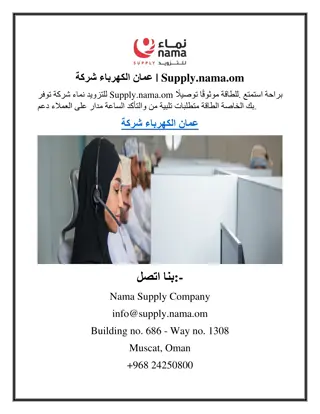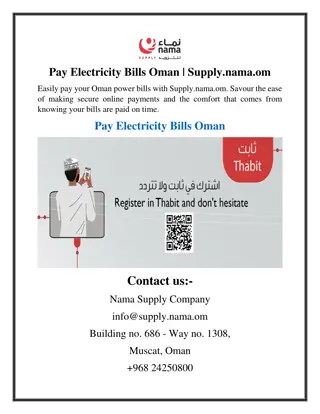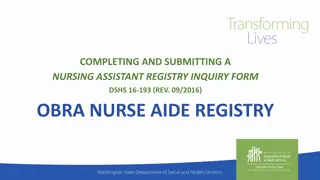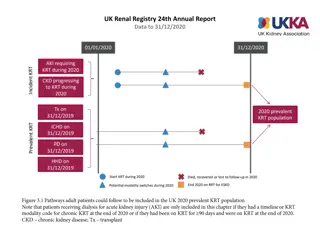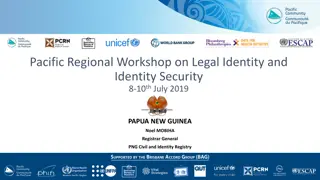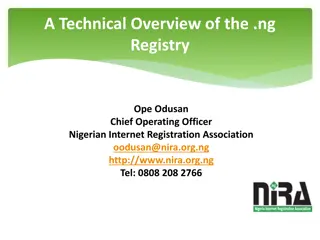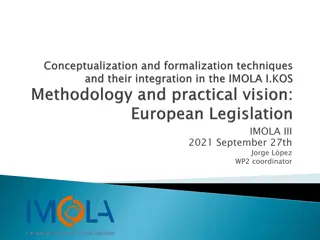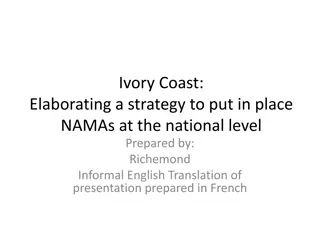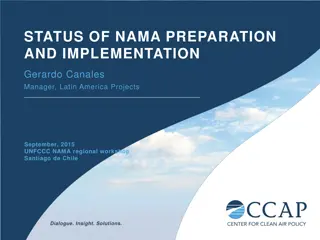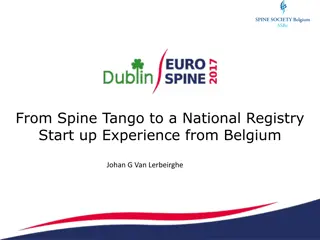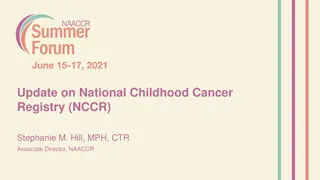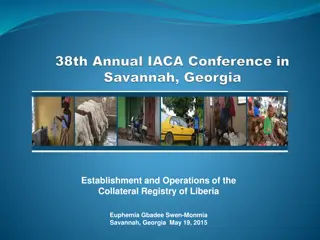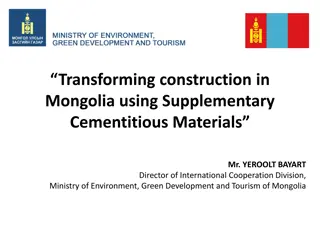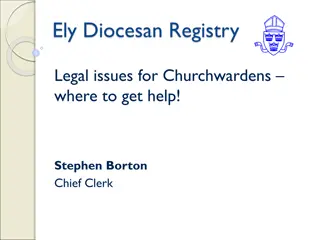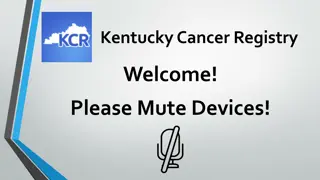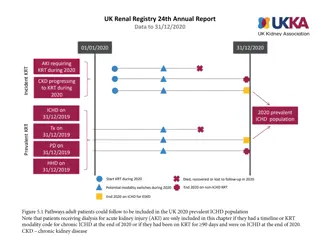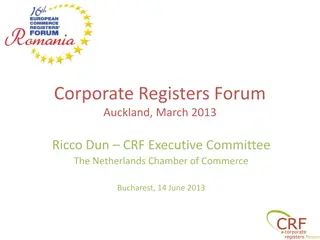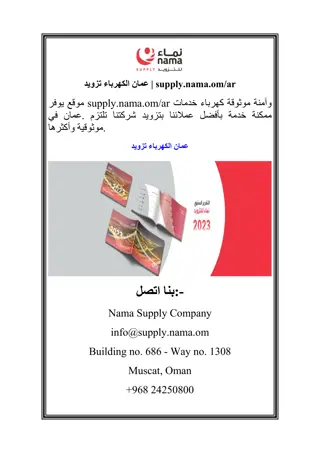Overview of NAMA Registry Report - Development, Challenges, and Opportunities
Established by the COP, the NAMA Registry serves to record mitigation actions voluntarily submitted for tracking. Explore the timeline of its development, fundamental characteristics, challenges, and operational aspects as detailed in the report. Gain insights into participation statistics, regional access rights, and the dynamic nature of this web-based platform.
Uploaded on Apr 04, 2025 | 0 Views
Download Presentation

Please find below an Image/Link to download the presentation.
The content on the website is provided AS IS for your information and personal use only. It may not be sold, licensed, or shared on other websites without obtaining consent from the author.If you encounter any issues during the download, it is possible that the publisher has removed the file from their server.
You are allowed to download the files provided on this website for personal or commercial use, subject to the condition that they are used lawfully. All files are the property of their respective owners.
The content on the website is provided AS IS for your information and personal use only. It may not be sold, licensed, or shared on other websites without obtaining consent from the author.
E N D
Presentation Transcript
The NAMA registry Report to SBI 40 Claudio Forner UNFCCC secretariat - Mitigation, Data and Analysis Programme
Summary Background Mandate for the registry Registry development timeline Registry fundamentals Operation of the Registry Overview of content Secretariat activity Challenges and opportunities
Mandate for the registry The COP decided to establish a registry to record nationally appropriate mitigation actions (1/CP.16) The COP also decided that the registry should be developed as a dynamic, web-based platform managed by a dedicated team in the secretariat (2/CP.17) Participation is voluntary and only the registry contains only information that has been submitted specifically for recording.
Registry development timeline Interim facility: August 2012 Fully functional prototype: April 2013 First release of the web based registry: October 2013. Second release of the web based registry: March 2014.
Overview of registry content in 2014 These statistics are as at 14 April 2014 Further analysis is available in the annual report of the registry
Overview of registry content in 2014: Summary of registry participation NAMAs Number of NAMA approvers Number of NAMA developers Number of NAMA entries 77 5 44 Support Number of support editors Number of support entries 25 9
Overview of registry content in 2014: Registry participation characterised by NAMA approver access rights By region, 30%-60% of developing countries requested access rights 100% 90% 3 1 80% 14 24 75 29 70% 33 29 60% 50% 40% 6 2 30% 19 29 77 19 20% 21 10 10% 0% African States Asia-Pacific States Eastern European States Latin America and Caribbean States Other SIDS LDCs Total NAI Parties Number of NAI Parties with access rights Number of NAI Parties without access rights
Overview of registry content in 2014: Registry participation characterised by NAMA entries Significantly fewer have gone the step further of creating an entry in the registry 100% 90% 80% 70% 60% 28 47 8 137 36 51 47 3 50% 40% 30% 20% 10% 5 7 1 15 3 2 1 0% African States Asia-Pacific States Eastern European States Latin Other SIDS LDCs Total NAI Parties America and Caribbean States Number of NAI Parties with NAMA entires Number of NAI Parties without NAMA entires
Overview of registry content in 2014: Characterization of NAMA entries by type The majority of NAMA entries are seeking support and the majority of these are seeking support for implementation
Overview of registry content in 2014: Characterization of NAMA entries by type Types of support needed is different by region
Overview of registry content in 2014: Characterization of NAMAs by sector The energy supply sector is the sector relevant to most NAMA entries
Overview of registry content in 2014: Type of financial support sought Grant funding is the type of financial support most commonly sought by NAMAs
Overview of registry content in 2014: Extent of matching For a match to be recorded, both the NAMA and the source of support should have an entry Both Parties have to agree on the type and amount of support (e.g, the registry seeks confirmation from the counterpart) To date, only two matches have been recorded in the registry: NS-85 ( Adaptive Sustainable Forest Management in Borjomi- Bakuriani Forest District ), by Georgia, received support from Austria (EUR 1.940.492) NS-95 ( Nationally Appropriate Mitigation Actions for low-carbon end-use sectors in Azerbaijan ), received support from the GEF (USD 100.000)
Challenges and opportunities Limited use and level of participation: the registry needs to contain a critical mass of information to be effective Improving information accuracy and completeness : registry content needs to be reliable and complete Limitations of final registry design: Functionality of registry determined by Parties but the secretariat received limited feedback from Parties on the design of the registry, in particular on the templates used for creating entries
Challenges and opportunities It is recommended that Parties and others who may benefit from the registry: a) Find ways to increase their level of participation in the registry, including obtaining access rights and creating registry entries. For developing country Parties , the ability to decentralize the preparation of NAMAs through NAMA developer access rights may facilitate participation b) Take steps to ensure that their entries in the registry are accurate, complete and up- to-date c) Continue to provide the secretariat with suggestions for improving the registry, with their related capacity-building needs and to make use of relevant technical resources
Challenges and opportunities The secretariat will continue to support for the registry, within the restrictions of mandate and budget: a) Capacity building through regional NAMA workshops a) Development of technical resources requested by Parties b) Outreach activities with potential providers of support and proponents of supported NAMAs c) Providing direct support to individual registry users d) Improving the registry platform
Annual report on registry operation: FCCC/CP/2013/INF.2 Report on the extent of matching: FCCC/SBI/2014/INF.10 To view the registry visit: http://unfccc.int/cooperation_support/nama/items/8184.php Jules Williams, Associate Programme Officer UNFCCC secretariat - Mitigation, Data and Analysis Programme


